A Garden Museum
Horticulturist Christine Price-Abelow ensures gardens at the National Museum of the American Indian tell the museum’s stories.
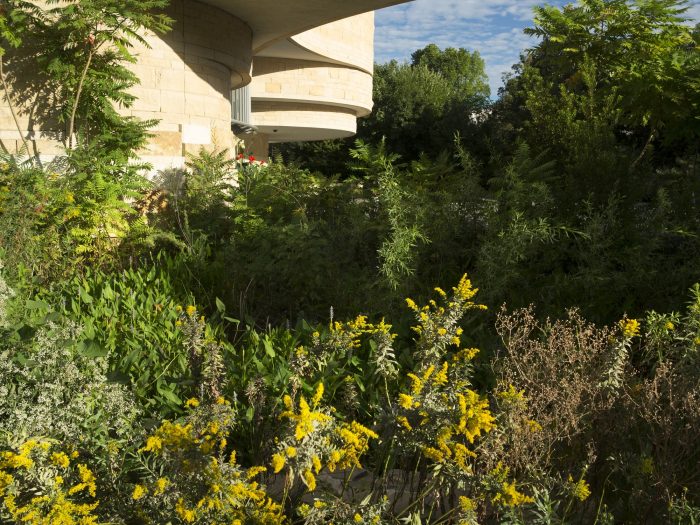
The gardens at the National Museum of the American Indian feature native plants in naturalized settings. (Photo courtesy of Smithsonian Gardens)
If you have been to the National Mall in Washington, D.C., there is one Smithsonian museum you might have walked through without noticing. It has no walls or giant columns. No airplanes, gemstones, postage stamps, or paintings. It is the Smithsonian Gardens, composed of more than 180 acres of outdoor gardens on nearly every Smithsonian property.
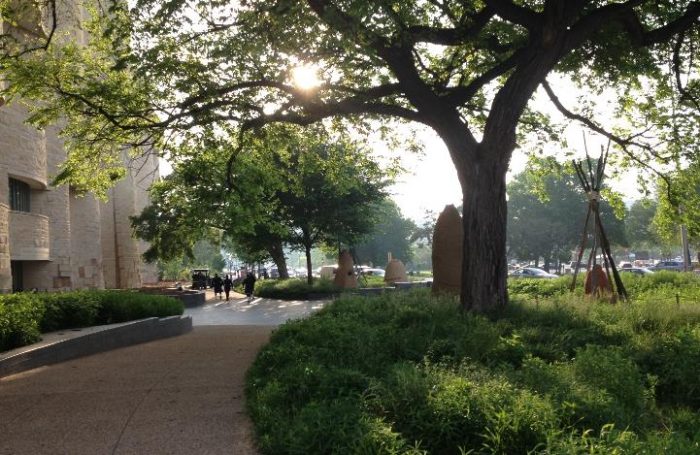
Naturalized plantings and sculpture subtly reflect Native American heritage and suggest the stories that can be found inside the museum. (Photo courtesy Smithsonian Gardens)
Many of the gardens reflect the themes of the museum where they are located. For example, the National Museum of the American Indian’s landscape features plants that flourished in the Piedmont region—which runs along the eastern side of the Appalachian Mountains and includes Washington, D.C.—prior to European contact. The curator of this native landscape is horticulturist Christine Price-Abelow. She has been managing this garden since shortly after the museum opened in 2004. Today, the garden features about 30 trees, 30 shrubs, and roughly 60 to 70 perennials and seasonal plants, all of which are native to—and still grow in—the Piedmont.
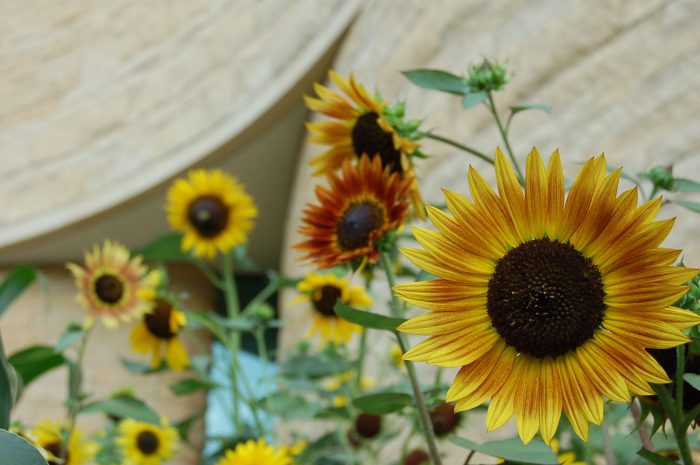
Sunflowers are among the native plants that can be found in the gardens of the National Museum of the American Indian. (Photo courtesy of Smithsonian Gardens.)
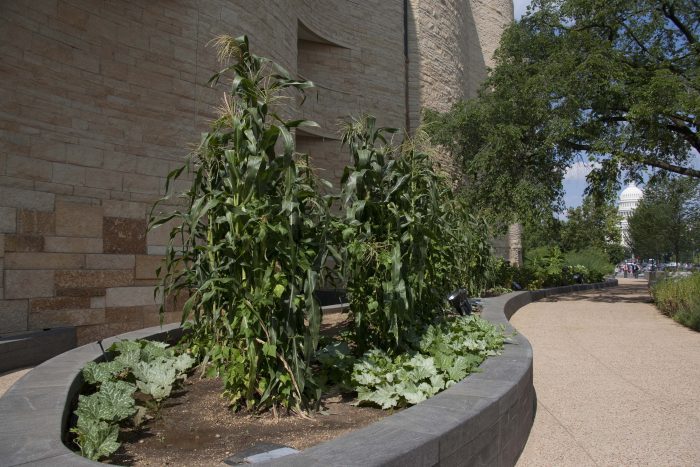
Corn plants in a raised bed at the National Museum of the American Indian. (Photo courtesy of Smithsonian Gardens)
“I like the connection our museum creates between people and the plants. The plants are like an exhibit themselves,” Price-Abelow explains. She and her team take great care to ensure the garden at the National Museum of the American Indian reflects the story of Native communities. The garden features ethnobotanical plants, or plants used for food, dyes, medicine, ceremony, and other human uses. “Each plant has a story to tell about how it relates to our collection [inside the museum], or the food in the café,” Price-Abelow said. “We get to connect with the public and reinforce how these plants play a role in our lives.”
Her team works with plant varieties found in nature, not varieties produced through selective breeding. She sources these plants either from nurseries that specialize in native plants or from the Smithsonian Gardens’ greenhouse facility in Suitland, Maryland, where the plants are propagated.
Although the garden has had two decades to establish itself, the work is never over. The plants have changed over the years. “[Due to climate change,] we’re certainly able to bring in plants that were sort of marginal on the hardiness scale years ago. Some of the stuff that, in the past, wouldn’t normally overwinter, but instead would only survive year-round in the tropics, are overwintering now and coming back in the spring more robustly,” Price-Abelow said. Further, the trees have changed over time, putting new pressures on the garden. Some have grown as much as 25 feet and have cast new shadows, while some have lost their lives to disease and their absence has exposed new ground to sunlight.

Smithsonian Garden staff work to keep the naturalized plantings from becoming a little too natural. (Photo courtesy of Smithsonian Gardens)
Price-Abelow’s affinity for gardening began when she was a child. She and her mother, a science teacher, would often take walks and hikes in the woods and work in their garden together. “I just gravitated towards it,” Price-Abelow said. “It was something we did together, and my mom still likes to garden, and she’s 85.” She also remembers playing in the fields on her aunt and uncle’s produce farm nearby.
On her 14-acre property in Maryland, Price-Abelow once kept a kitchen garden of her own until it began bearing more vegetables than she could handle. Her private flower garden still reminds her of the passion she developed as a child that grew into studying horticulture at Virginia Tech. This passion took her from a job at a retail garden center to landscaping a 90-acre property owned by the U.S. Postal Service to the Smithsonian Gardens.
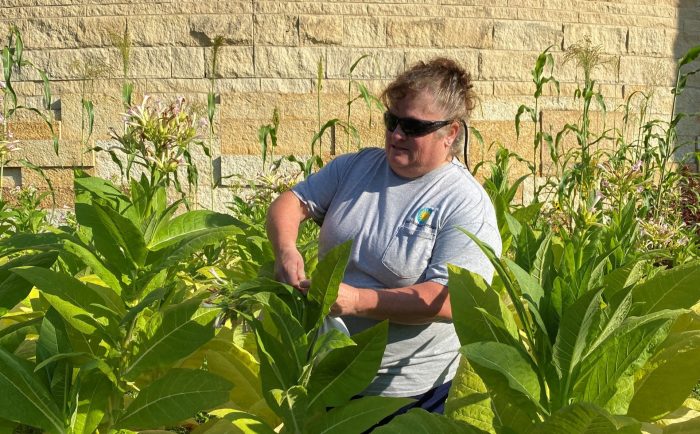
Horticulturist Christine Price-Abelow works in the garden at the National Museum of the American Indian in Washington, D.C. (Photo by Ben Marcus)
“I never really thought I’d wind up here in DC, because I grew up in kind of a small town. You never know where you’re going to end up.”
Price-Abelow’s favorite tree in the garden is a large, hardy American Elm tree, which resides in the landscape’s meadow habitat section. “It’s one of the largest trees in our collection, and it’s a true American Elm, which is kind of rare in D.C. because of Dutch Elm disease,” she said. The team gives the tree treatments to prevent disease; across the garden, they use various natural treatments, including beneficial insects. “You can use integrated pest management techniques where you release a good insect to go after a bad insect, which is something I usually do around our cropland and vegetable plants,” she continued.
On your next trip to Washington, D.C., remember to stop and look at the gardens, both at the National Museum of the American Indian and our other museums. You just might see Price-Abelow in her little green golf cart, tending to the garden and keeping it healthy for all of us to enjoy.
Interested in learning more? Native Landscape at the National Museum of the American Indian – Smithsonian Gardens
Eye on Science shines a light on our vast and varied body of work by bringing Smithsonian science into sharper focus. Eye on Science tells the stories of the people behind the research, the discoveries they make and their inspiration. We will explore their passions, celebrate their contributions, and look more closely at how questions become solutions that can inform environmental policy, spur technological innovation, and promote community and collaboration across the globe. Eye on Science is also published by si.edu as Meet a Scientist.
Posted: 2 December 2024
- Categories:




Great article! Christine is the unsung hero of NMAI’s landscape.